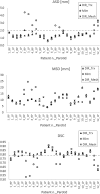A Comparative Evaluation of 3 Different Free-Form Deformable Image Registration and Contour Propagation Methods for Head and Neck MRI: The Case of Parotid Changes During Radiotherapy
- PMID: 28168934
- PMCID: PMC5616054
- DOI: 10.1177/1533034617691408
A Comparative Evaluation of 3 Different Free-Form Deformable Image Registration and Contour Propagation Methods for Head and Neck MRI: The Case of Parotid Changes During Radiotherapy
Abstract
Purpose: To validate and compare the deformable image registration and parotid contour propagation process for head and neck magnetic resonance imaging in patients treated with radiotherapy using 3 different approaches-the commercial MIM, the open-source Elastix software, and an optimized version of it.
Materials and methods: Twelve patients with head and neck cancer previously treated with radiotherapy were considered. Deformable image registration and parotid contour propagation were evaluated by considering the magnetic resonance images acquired before and after the end of the treatment. Deformable image registration, based on free-form deformation method, and contour propagation available on MIM were compared to Elastix. Two different contour propagation approaches were implemented for Elastix software, a conventional one (DIR_Trx) and an optimized homemade version, based on mesh deformation (DIR_Mesh). The accuracy of these 3 approaches was estimated by comparing propagated to manual contours in terms of average symmetric distance, maximum symmetric distance, Dice similarity coefficient, sensitivity, and inclusiveness.
Results: A good agreement was generally found between the manual contours and the propagated ones, without differences among the 3 methods; in few critical cases with complex deformations, DIR_Mesh proved to be more accurate, having the lowest values of average symmetric distance and maximum symmetric distance and the highest value of Dice similarity coefficient, although nonsignificant. The average propagation errors with respect to the reference contours are lower than the voxel diagonal (2 mm), and Dice similarity coefficient is around 0.8 for all 3 methods.
Conclusion: The 3 free-form deformation approaches were not significantly different in terms of deformable image registration accuracy and can be safely adopted for the registration and parotid contour propagation during radiotherapy on magnetic resonance imaging. More optimized approaches (as DIR_Mesh) could be preferable for critical deformations.
Keywords: Elastix; MIM; accuracy evaluation; contour propagation; head and neck MRI; image registration.
Conflict of interest statement
Figures





Similar articles
-
Comprehensive evaluation of ten deformable image registration algorithms for contour propagation between CT and cone-beam CT images in adaptive head & neck radiotherapy.PLoS One. 2017 Apr 17;12(4):e0175906. doi: 10.1371/journal.pone.0175906. eCollection 2017. PLoS One. 2017. PMID: 28414799 Free PMC article.
-
Evaluation of a commercial DIR platform for contour propagation in prostate cancer patients treated with IMRT/VMAT.J Appl Clin Med Phys. 2020 Feb;21(2):14-25. doi: 10.1002/acm2.12787. J Appl Clin Med Phys. 2020. PMID: 32058663 Free PMC article.
-
Evaluation of the accuracy of deformable image registration on MRI with a physical phantom.J Appl Clin Med Phys. 2020 Jan;21(1):166-173. doi: 10.1002/acm2.12789. Epub 2019 Dec 6. J Appl Clin Med Phys. 2020. PMID: 31808307 Free PMC article.
-
Deformable image registration for radiation therapy: principle, methods, applications and evaluation.Acta Oncol. 2019 Sep;58(9):1225-1237. doi: 10.1080/0284186X.2019.1620331. Epub 2019 Jun 3. Acta Oncol. 2019. PMID: 31155990 Review.
-
Roles of Deformable Image Registration in adaptive RT: From contour propagation to dose monitoring.Annu Int Conf IEEE Eng Med Biol Soc. 2015;2015:5215-8. doi: 10.1109/EMBC.2015.7319567. Annu Int Conf IEEE Eng Med Biol Soc. 2015. PMID: 26737467 Review.
Cited by
-
Inter-fraction movements of the prostate and pelvic lymph nodes during IGRT.J Radiat Oncol. 2018;7(4):357-366. doi: 10.1007/s13566-018-0366-3. Epub 2018 Nov 28. J Radiat Oncol. 2018. PMID: 30595810 Free PMC article.
-
Mesh-to-raster region-of-interest-based nonrigid registration of multimodal images.J Med Imaging (Bellingham). 2017 Oct;4(4):044002. doi: 10.1117/1.JMI.4.4.044002. Epub 2017 Oct 27. J Med Imaging (Bellingham). 2017. PMID: 29098167 Free PMC article.
-
A hybrid proton and hyperpolarized gas tagging MRI technique for lung respiratory motion imaging: a feasibility study.Phys Med Biol. 2019 May 16;64(10):105019. doi: 10.1088/1361-6560/ab160c. Phys Med Biol. 2019. PMID: 30947154 Free PMC article.
-
Brain CT registration using hybrid supervised convolutional neural network.Biomed Eng Online. 2021 Dec 29;20(1):131. doi: 10.1186/s12938-021-00971-8. Biomed Eng Online. 2021. PMID: 34965854 Free PMC article.
-
Effect of age-dependent bone electron density on the calculated dose distribution from kilovoltage and megavoltage photon and electron radiotherapy in paediatric MRI-only treatment planning.Br J Radiol. 2018 Jan;91(1081):20170511. doi: 10.1259/bjr.20170511. Epub 2017 Nov 9. Br J Radiol. 2018. PMID: 29091480 Free PMC article.
References
-
- Barker JL, Garden AS, Ang KK, et al. Quantification of volumetric and geometric changes occurring during fractionated radiotherapy for head-and-neck cancer using an integrated CT/linear accelerator system. Int J Radiat Oncol Biol Phys. 2004;59(4):960–970. - PubMed
-
- Nishi T, Nishimura Y, Shibata T, Tamura M, Nishigaito N, Okumura M. Volume and dosimetric changes and initial clinical experience of a two-step adaptive intensity modulated radiation therapy (IMRT) scheme for head and neck cancer. Radiother Oncol. 2013;106(1):85–89. - PubMed
-
- Hansen EK, Bucci MK, Quivey JM, Weinberg V, Xia P. Repeat CT imaging and replanning during the course of IMRT for head-and-neck cancer. Int J Radiat Oncol Biol Phys. 2006;64(2):355–362. - PubMed
-
- Lee C, Langen KM, Lu W, et al. Assessment of parotid gland dose changes during head and neck cancer radiotherapy using daily megavoltage computed tomography and deformable image registration. Int J Radiat Oncol Biol Phys. 2008;71(5):1563–1571. - PubMed
Publication types
MeSH terms
LinkOut - more resources
Full Text Sources
Other Literature Sources
Medical

